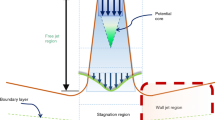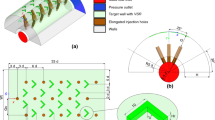Abstract
To deal with the aerodynamic heating on the aircraft surface, a potential solution is to utilize liquid cooling via the channels in part of the fuselage. This is a typical problem of flow and heat transfer in channels with unilaterally-heated surfaces. The enhancement of heat transfer in the channel is significant due to the high heating flux. The optimal velocity and temperature fields are obtained first based on the field synergy optimization method. Four rib configurations are proposed to produce the longitudinal vortices suggested by the optimal velocity field. The flow and heat transfer characteristics of different rib configurations are obtained by numerical simulation. The numerical simulations show that the heat transfer enhancement of the rib configurations are quite different, but the pressure drop increases similarly in the laminar flow range of Re = 500–1500. The mechanism of heat transfer enhancement with the single/double-inclined ribs for the unilaterally-heated channel is analysed. The best enhancement of geometric parameter among the investigated parameters such as the angle, length, radius and the spacing of the ribs is obtained.
Similar content being viewed by others
References
Van Driest E R. The problem of aerodynamic heating. Aerodynamic Aspects Session, National Summer Meeting, IAS. Los Angeles, Institute of the Aeronautical Sciences, 1956
Thornton E A. Thermal Structures for Aerospace Applications. Reston: AIAA, 1996
Wuchina E, Opeka M, Causey S, et al. Designing for ultrahigh-temperature applications: The mechanical and thermal properties of HfB2, HfCx, HfNx and αHf(N). J Mater Sci, 2004, 39: 5939–5949
Monteverde F, Scatteia L. Resistance to thermal shock and to oxidation of metal diborides-SiC ceramics for aerospace application. J Am Ceramic Soc, 2007, 90: 1130–1138
Kasen S D. Thermal management at hypersonic leading edges. Dissertation for Doctoral Degree. Charlottesville: University of Virginia, 2013
Zhu Y, Peng W, Xu R, et al. Review on active thermal protection and its heat transfer for airbreathing hypersonic vehicles. Chin J Aeronautics, 2018, 31: 1929–1953
Uyanna O, Najafi H. Thermal protection systems for space vehicles: A review on technology development, current challenges and future prospects. Acta Astronaut, 2020, 176: 341–356
Glass D. Ceramic matrix composite (CMC) thermal protection systems (TPS) and hot structures for hypersonic vehicles. In: Proceedings of the 15th AIAA International Space Planes and Hypersonic Systems and Technologies Conference. Dayton, 2008. 2682
Schwanekamp T. System studies on active thermal protection of a hypersonic suborbital passenger transport vehicle. In: Proceedings of the 19th AIAA International Space Planes and Hypersonic Systems and Technologies Conference. Atlanta, 2014. 2372
Guo Z Y, Tao W Q, Shah R K. The field synergy (coordination) principle and its applications in enhancing single phase convective heat transfer. Int J Heat Mass Transfer, 2005, 48: 1797–1807
Tao W Q, Guo Z Y, Wang B X. Field synergy principle for enhancing convective heat transfer—its extension and numerical verifications. Int J Heat Mass Transfer, 2002, 45: 3849–3856
Guo Z Y, Zhu H Y, Liang X G. Entransy—A physical quantity describing heat transfer ability. Int J Heat Mass Transfer, 2007, 50: 2545–2556
Chen Q, Liang X G, Guo Z Y. Entransy theory for the optimization of heat transfer—A review and update. Int J Heat Mass Transfer, 2013, 63: 65–81
Cheng X T, Wang X Y, Liang X G. Role of viscous heating in entransy analyses of convective heat transfer. Sci China Tech Sci, 2020, 63: 2154–2162
Wu J, Liang X G. Application of entransy dissipation extremum principle in radiative heat transfer optimization. Sci China Ser E-Technol Sci, 2008, 51: 1306–1314
He Y L, Tao W Q. Numerical studies on the inherent interrelationship between field synergy principle and entransy dissipation extreme principle for enhancing convective heat transfer. Int J Heat Mass Transfer, 2014, 74: 196–205
Meng J A, Liang X G, Li Z X. Field synergy optimization and enhanced heat transfer by multi-longitudinal vortexes flow in tube. Int J Heat Mass Transfer, 2005, 48: 3331–3337
Chen Q, Wang M, Pan N, et al. Optimization principles for convective heat transfer. Energy, 2009, 34: 1199–1206
Meng J A, Liang X G, Chen Z J, et al. Experimental study on convective heat transfer in alternating elliptical axis tubes. Exp Thermal Fluid Sci, 2005, 29: 457–465
Meng J A, Li Z X, Guo Z Y. Performance of enhanced heat transfer tube with discrete double-inclined ribs. J Chem Ind Eng, 2005, 56: 995–998
Tang X Y, Zhu D S. Flow structure and heat transfer in a narrow rectangular channel with different discrete rib arrays. Chem Eng Process-Process Intensif, 2013, 69: 1–14
Zheng N, Liu W, Liu Z, et al. A numerical study on heat transfer enhancement and the flow structure in a heat exchanger tube with discrete double inclined ribs. Appl Thermal Eng, 2015, 90: 232–241
Jia H, Liu W, Liu Z. Enhancing convective heat transfer based on minimum power consumption principle. Chem Eng Sci, 2012, 69: 225–230
Liu W, Jia H, Liu Z C, et al. The approach of minimum heat consumption and its applications in convective heat transfer optimization. Int J Heat Mass Transfer, 2013, 57: 389–396
Wang J, Liu W, Liu Z. The application of exergy destruction minimization in convective heat transfer optimization. Appl Thermal Eng, 2015, 88: 384–390
Liu W, Liu P, Wang J B, et al. Exergy destruction minimization: A principle to convective heat transfer enhancement. Int J Heat Mass Transfer, 2018, 122: 11–21
Xiao H, Wang J, Liu Z, et al. Turbulent heat transfer optimization for solar air heater with variation method based on exergy destruction minimization principle. Int J Heat Mass Transfer, 2019, 136: 1096–1105
Zheng N, Yan F, Zhang K, et al. A review on single-phase convective heat transfer enhancement based on multi-longitudinal vortices in heat exchanger tubes. Appl Thermal Eng, 2020, 164: 114475
Han J C, Chen H C. Turbine blade internal cooling passages with rib turbulators. J Propulsion Power, 2006, 22: 226–248
Ye L, Liu C, Liu H, et al. Experimental and numerical study on the effects of rib orientation angle on film cooling performance of compound angle holes. Int J Heat Mass Transfer, 2018, 126: 1099–1112
Moon M A, Park M J, Kim K Y. Evaluation of heat transfer performances of various rib shapes. Int J Heat Mass Transfer, 2014, 71: 275–284
Peng W, Jiang P X, Wang Y P, et al. Experimental and numerical investigation of convection heat transfer in channels with different types of ribs. Appl Thermal Eng, 2011, 31: 2702–2708
Li Z, Lu J, Tang G, et al. Effects of rib geometries and property variations on heat transfer to supercritical water in internally ribbed tubes. Appl Thermal Eng, 2015, 78: 303–314
Huh M, Liu Y H, Han J C. Effect of rib height on heat transfer in a two pass rectangular channel (AR=1:4) with a sharp entrance at high rotation numbers. Int J Heat Mass Transfer, 2009, 52: 4635–4649
Webb R L. Performance evaluation criteria for use of enhanced heat transfer surfaces in heat exchanger design. Int J Heat Mass Transfer, 1981, 24: 715–726
Phillips R J. Forced-convection, liquid-cooled, microchannel heat sinks. Cambridge: Massachusetts Institute of Technology, 1987
Author information
Authors and Affiliations
Corresponding author
Additional information
This work was supported by discipline construction fund of Tsinghua University.
Rights and permissions
About this article
Cite this article
Wang, X., Xu, X. & Liang, X. Enhancement of laminar flow heat transfer with single/double-inclined ribs for unilaterally-heated channel. Sci. China Technol. Sci. 66, 2108–2118 (2023). https://doi.org/10.1007/s11431-022-2211-0
Received:
Accepted:
Published:
Issue Date:
DOI: https://doi.org/10.1007/s11431-022-2211-0




